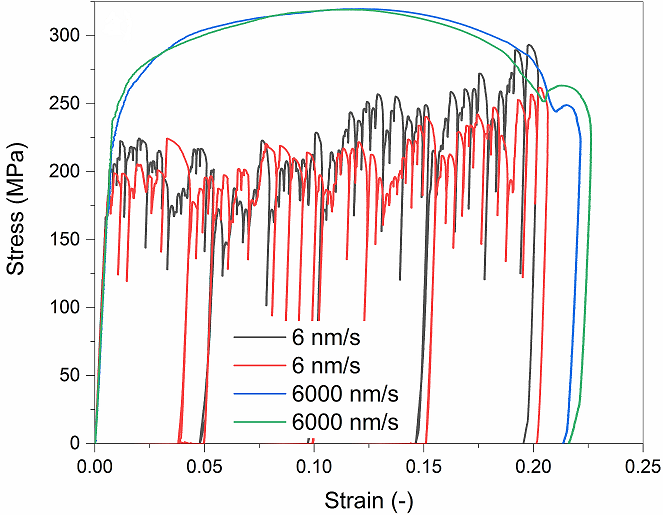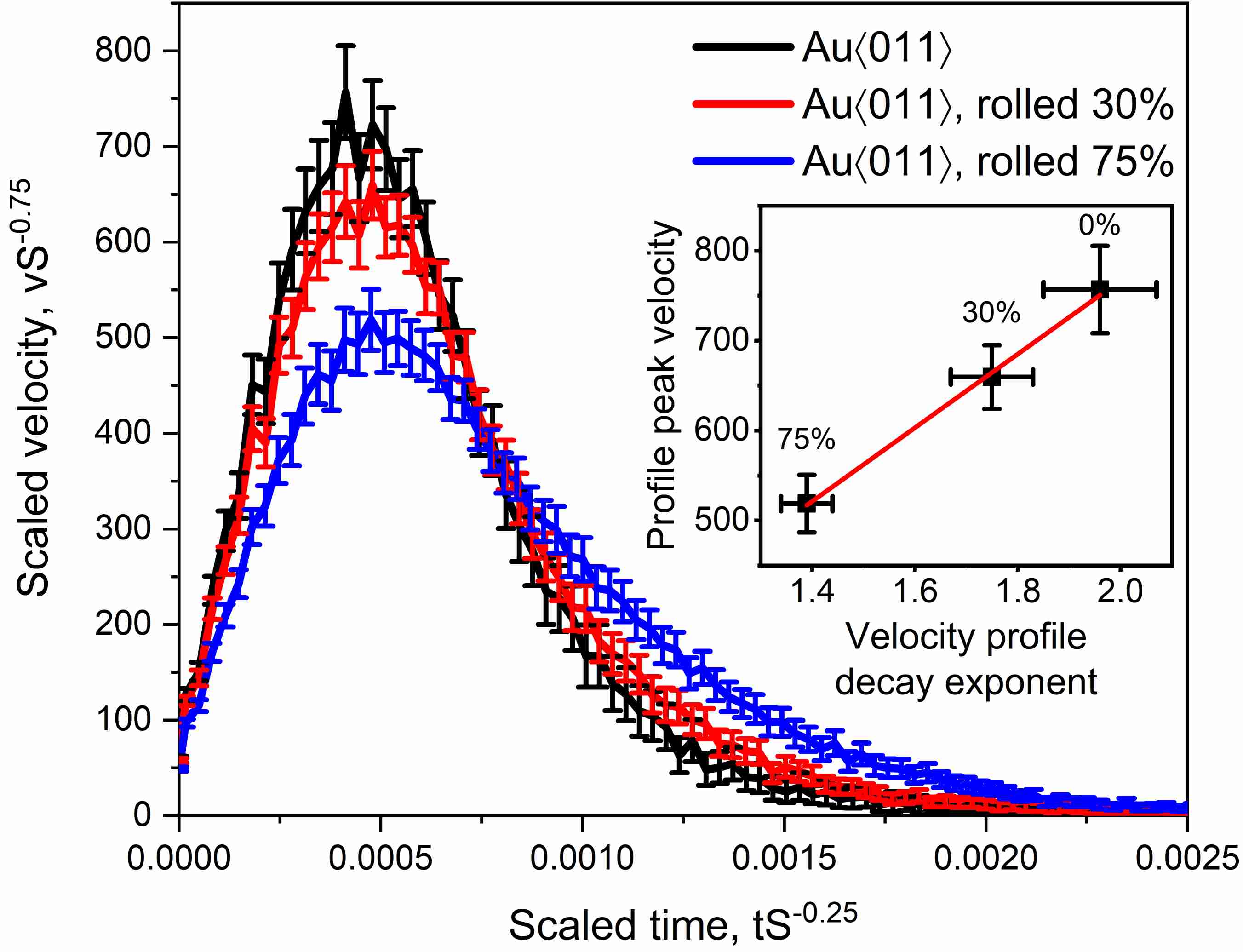 Small crystals offer unseen possibilities to study some fundamental aspects of plastic deformation. One of them is that plastic flow is intermittent and to some degree scale-free. We use advanced small-scale mechanical testing methods to unravel time-resolved and statistical properties of intermittent flow. Our current efforts in this research area are supported by the NSF CAREER program (DMR-MMN), and we are very grateful for the financial support we receive.
Small crystals offer unseen possibilities to study some fundamental aspects of plastic deformation. One of them is that plastic flow is intermittent and to some degree scale-free. We use advanced small-scale mechanical testing methods to unravel time-resolved and statistical properties of intermittent flow. Our current efforts in this research area are supported by the NSF CAREER program (DMR-MMN), and we are very grateful for the financial support we receive.
Why do we observe intermittent plasticity at the small scale, but not at larger scales?
 Straining a macroscopic metallic material is typically leading to a smooth plastic stress-strain response. However, when the size of the sample reduces, the crystal deforms in bursts. This is not only a problem for metals shaping at the small scale, but also raises the fundamental question why this phenomenon is only seen at small, but not at large scales. In collaboration with the group of Prof. Jaime Marian at UCLA, we addressed this question, and can show that the smooth-to-intermittent transition of metals plasticity upon decreasing sample size is fundamentally driven by a time-scale or velocity mismatch between the applied deformation rate and the underlying defect dynamics in the material. Indeed, our efforts in tracing collective dislocation avalanches in real time reveal finite velocities. This means, an external applied deformation rate may exceed the avalanche velocity, thereby promoting smooth flow. This observation aligns with the well-known transitions from serrated to non-serrated flow in metallic glasses or materials with dynamic strain aging.
Straining a macroscopic metallic material is typically leading to a smooth plastic stress-strain response. However, when the size of the sample reduces, the crystal deforms in bursts. This is not only a problem for metals shaping at the small scale, but also raises the fundamental question why this phenomenon is only seen at small, but not at large scales. In collaboration with the group of Prof. Jaime Marian at UCLA, we addressed this question, and can show that the smooth-to-intermittent transition of metals plasticity upon decreasing sample size is fundamentally driven by a time-scale or velocity mismatch between the applied deformation rate and the underlying defect dynamics in the material. Indeed, our efforts in tracing collective dislocation avalanches in real time reveal finite velocities. This means, an external applied deformation rate may exceed the avalanche velocity, thereby promoting smooth flow. This observation aligns with the well-known transitions from serrated to non-serrated flow in metallic glasses or materials with dynamic strain aging.
Nontrivial scaling exponents of avalanche statistics in microplasticity
Single crystalline micro-scale crystals deform in discrete bursts in analogy to plate tectonics. Their probability distribution follows a power-law with an exponential cutoff. Properties of the system, such as, symmetry, dimension, and interaction range, dictate the universality class, and thus the statistical properties, of the system. In collaboration with the group of Prof. Karin Dahmen, we here investigate the parameters that affect the scaling behavior of the probability distributions. Whilst many reports argue for universal scaling exponents in microplasticity, we find clear experimental evidence that this is not the case. Indeed, many material specific properties are sensitively affecting the statistical signature of intermittent plastic flow. The novel developments open up avenues to incorporate material-specific details into statistical deformation models.
system, such as, symmetry, dimension, and interaction range, dictate the universality class, and thus the statistical properties, of the system. In collaboration with the group of Prof. Karin Dahmen, we here investigate the parameters that affect the scaling behavior of the probability distributions. Whilst many reports argue for universal scaling exponents in microplasticity, we find clear experimental evidence that this is not the case. Indeed, many material specific properties are sensitively affecting the statistical signature of intermittent plastic flow. The novel developments open up avenues to incorporate material-specific details into statistical deformation models.
Slip kinetics during intermittent flow of nano- and micro-crystals

Here we directly measure the spatiotemporal characteristics of dislocation avalanches during plastic flow of nano- and micro-crystals. This ongoing project reveals intriguing findings, such as an insensitivity of the dislocation avalanche to applied stress. We also find remarkable differences in the velocity relaxation of time-resolved avalanche shapes in fcc and bcc crystals that both depend on crystal orientation and initial dislocation density. Our experimental results are used to test emerging models for general avalanches dynamics. Even though theory predicts a universal behavior in avalanche dynamics across all metals, we find deviations from such behavior and non-trivial exponents. Stay tuned, and follow our next research activities that examine collective dislocation dynamics.
Selected publications:
- Avalanche statistics and the intermittent-to-smooth transition in microplasticity (2019)
- Effects on orientation and pre-deformation on velocity profiles of dislocation avalanches in gold microcrystals (2019)
- Nontrivial scaling exponents of dislocation avalanches in Au and Nb microcrystals (2018)
- Fast slip velocity in a high-entropy alloy (2018)
- Spatiotemporal slip dynamics during deformation of gold micro-crystals (2017)
- Independence of slip velocities on applied stress in small crystals (2015)
- Small-scale plasticity – Insights into dislocation avalanche velocities (2013)
Any opinions, findings, and conclusions or recommendations expressed in this material are those of the author(s) and do not necessarily reflect the views of the National Science Foundation.
